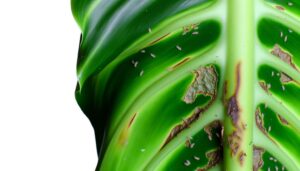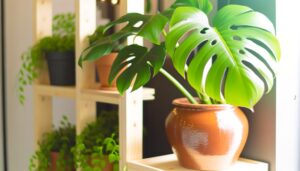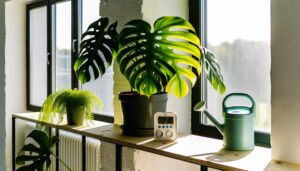Monstera Adansonii Propagation Without Leaves
You can propagate Monstera Adansonii without leaves by concentrating on healthy nodes. First, select a stem with at least one robust node, free of disease.
Make a clean cut below the node using sterilized pruning shears. Clean the node thoroughly and prepare it for rooting.
Choose water propagation by submerging the node in room-temperature water or use a well-draining potting mix for soil propagation. Maintain high humidity and place the cuttings in indirect bright light.
Monitor closely for ideal moisture and light conditions. This step-by-step method ensures successful root development and further techniques are just ahead.
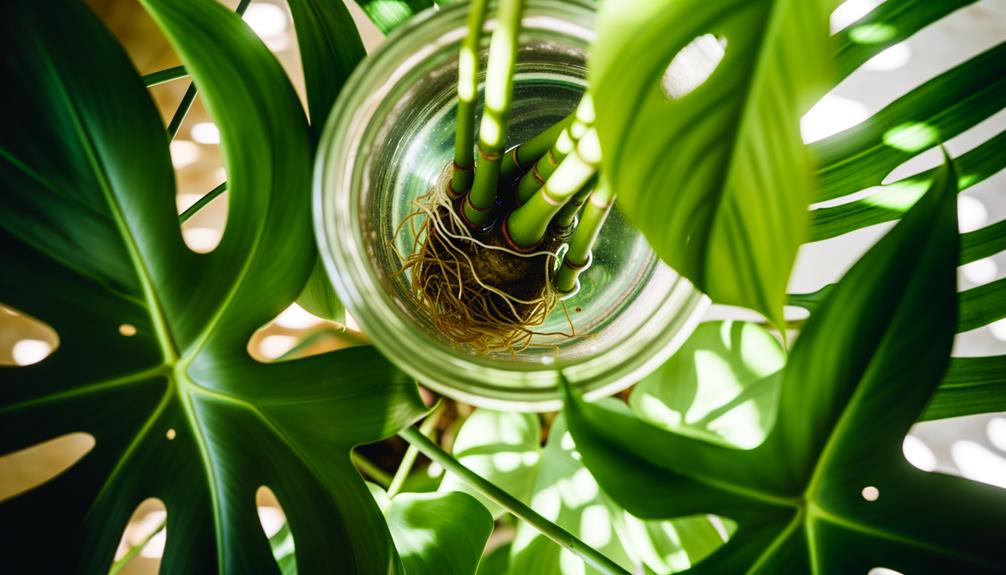
Key Takeaways
- Select a healthy stem with at least one node for propagation.
- Clean the node from any debris and damaged tissue.
- Use water propagation by submerging the node in clean, room-temperature water.
- Maintain high humidity and consistent moisture levels during rooting.
- Position the cutting in indirect bright light for optimal growth.
Choosing the Right Cutting
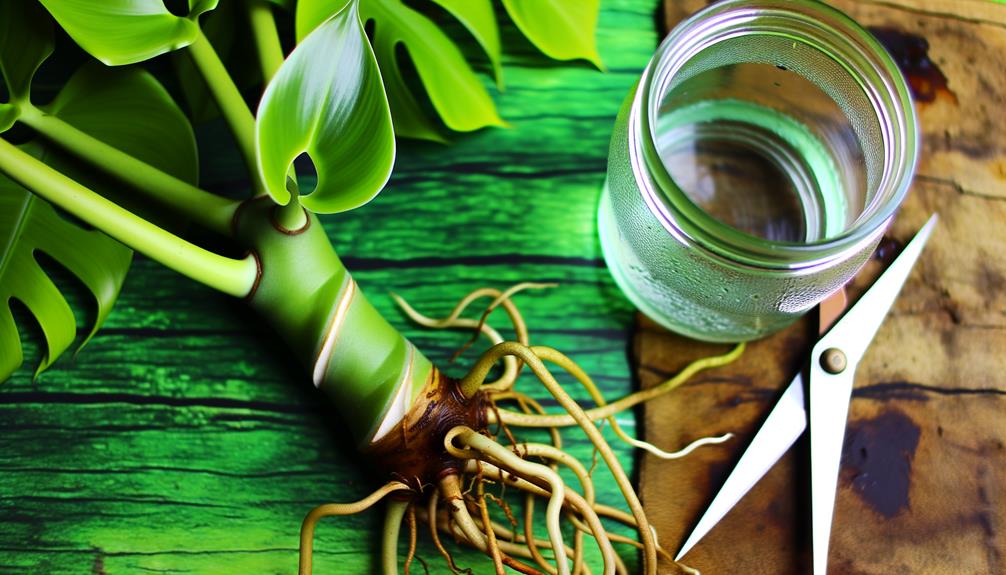
To choose the right cutting for Monstera Adansonii propagation, make certain you select a healthy stem with at least one node and a few leaves. Carefully inspect the plant to identify a robust, disease-free stem. Use sterilized pruning shears to make a clean cut just below the node. Confirm the cutting is about 4-6 inches in length.
The node, a small bump where new roots will emerge, is essential for successful propagation. Avoid stems with yellowing or damaged leaves, as they indicate poor health. By meticulously selecting a vigorous cutting, you enhance the likelihood of successful root development and plant growth.
This precise methodology guarantees your Monstera Adansonii propagation effort starts on a strong foundation.
Preparing the Node
Ensure the node is clean and free from any debris to facilitate best root development. Use sterilized scissors to trim any remaining foliage or damaged tissue around the node. Clean the node gently using a soft brush dipped in distilled water. This promotes no pathogens hinder the propagation process.
| Step | Description |
|---|---|
| 1. Trim | Use sterilized scissors to remove foliage and damaged tissue. |
| 2. Clean | Gently brush the node using a soft brush and distilled water. |
| 3. Inspect | Check the node for any signs of disease or damage. |
| 4. Prepare | Place the node on a clean, dry surface, ensuring it's ready for rooting. |
Pay attention to cleanliness to promote optimal root growth and robust plant health.
Rooting Methods
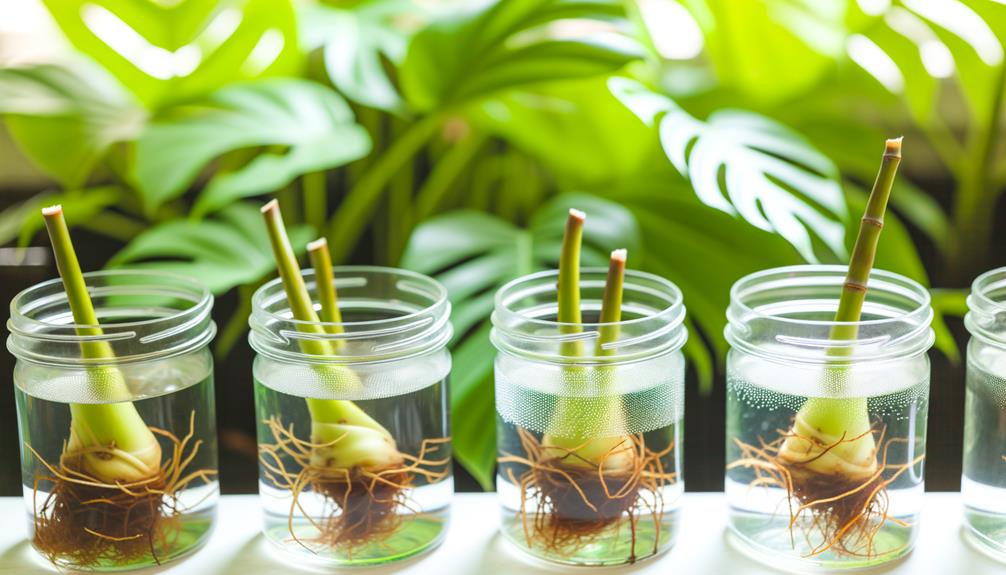
With the node meticulously prepared, the next step involves selecting an appropriate rooting method to guarantee successful propagation of your Monstera Adansonii.
You can choose between water propagation and soil propagation.
For water propagation, submerge the node in a container of clean, room-temperature water, ensuring it remains submerged but not the entire cutting. Change the water every few days to prevent stagnation.
For soil propagation, plant the node in a well-draining potting mix, ensuring it's slightly moist but not waterlogged. Maintain high humidity by covering the pot with a plastic bag.
Both methods require indirect light and stable temperatures. Select the method that best fits your environment to optimize root development.
Care During Rooting
Consistently monitor moisture levels and light exposure to maintain ideal conditions for your Monstera Adansonii during the rooting phase.
Utilize a humidity dome or plastic wrap to enhance ambient moisture, ensuring the medium remains consistently damp but not waterlogged.
Position your cuttings in indirect bright light; direct sunlight may cause desiccation.
Employ a well-aerated medium like sphagnum moss or perlite for prime root development.
Maintain temperatures between 65-75°F (18-24°C) to facilitate enzymatic activities essential for root growth.
Periodically check for fungal or bacterial infections, removing affected sections promptly.
Use a balanced, diluted liquid fertilizer (1/4 strength) bi-weekly to supply essential nutrients.
Transition to Soil
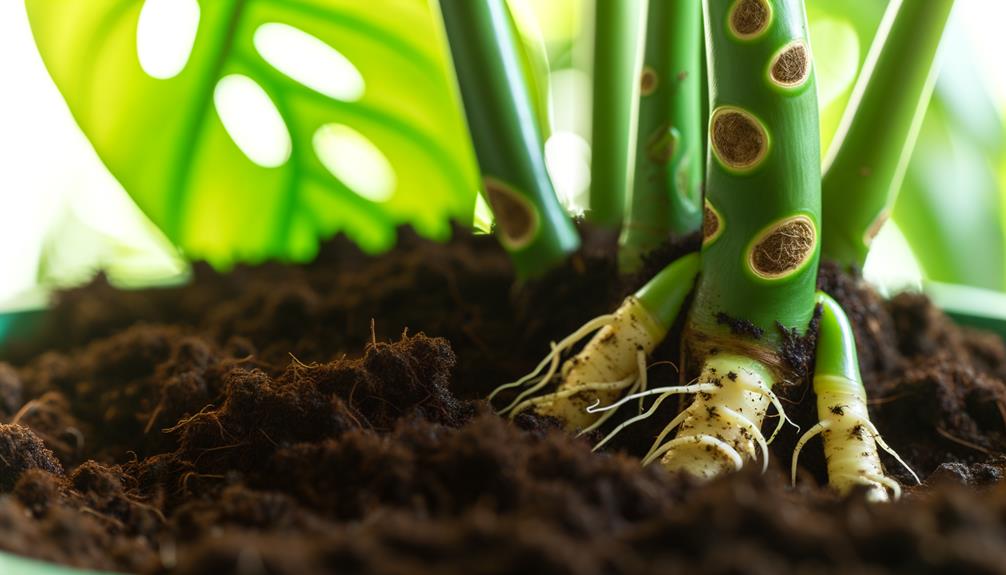
After establishing a healthy root system, you should prepare to shift your Monstera Adansonii cuttings into soil for ongoing growth and development. Begin by selecting a well-draining potting mix, ideally containing perlite or orchid bark to guarantee proper aeration.
Fill a suitable pot with the mix, creating a small hole in the center. Gently place the cutting into the hole, making sure the roots are spread out. Cover the roots with soil, pressing lightly to secure the cutting.
Water the soil thoroughly but avoid waterlogging, as excess moisture can lead to root rot. Position the pot in a location with bright, indirect light. Maintain consistent humidity and monitor soil moisture to support the shift and promote healthy growth.
Conclusion
By following these steps—choosing the right cutting, preparing the node, employing effective rooting methods, and providing diligent care—you'll maximize your chances of successfully propagating Monstera adansonii without leaves.
Remember, patience is key. As roots develop and the cutting shifts to soil, you'll witness the transformation from a bare node to a thriving plant.
Isn't nature's resilience remarkable? Your dedication to precise methodology will surely yield fruitful results.

